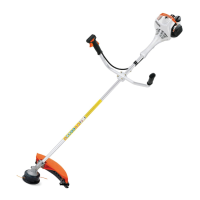FS 55, FS 55 C, FS 55 R, FS 55 RC
English
7
marks on the grip of the cap and on the
fuel tank opening lining up. Using the
grip, press the cap down firmly while
turning it clockwise as far as it will go
(approx. 1/4 turn).
Misaligned, damaged or broken cap
N If the cap does not drop fully into the
opening when the positioning marks
line up and/or if the cap does not
tighten properly when twisted, the
base of the cap may be prematurely
rotated (in relation to the top) to the
closed position. Such misalignment
can result from handling, cleaning
or an improper attempt at
tightening.
N To return the cap to the open
position for installation, turn the cap
(with the grip up) until it drops fully
into the tank opening. Next, twist the
cap counterclockwise as far as it will
go (approx. 1/4 turn) – this will twist
the base of the cap into the correct
position. Then, twist the cap
clockwise, closing it normally.
N If your cap still does not tighten
properly, it may be damaged or
broken; immediately stop use of the
unit and take it to your authorized
STIHL dealer for repair.
Screw Cap
See also the "Fueling" chapter in your
Instruction Manual for additional
information.
Before Starting
Fold the grip flush with
the top of the cap. Grip
the cap and check for
tightness. If the grip does
not lie completely flush
with the cap and the
detent on the grip does
not fit in the correspond-
ing recess in the filler
opening, or if the cap is
loose in the filler opening,
the cap is not properly
seated and tightened and
you must repeat the
above steps.
Left: Base of cap in closed posi-
tion (with open space)
Right: Base of cap correctly posi-
tioned for installation
Warning!
Unit vibrations can cause
an improperly tightened
fuel filler cap to loosen or
come off and spill quanti-
ties of fuel. In order to
reduce the risk of fuel
spillage and fire, tighten the fuel filler
cap by hand as securely as possible.
Warning!
Always check your power tool for proper
condition and operation before starting,
particularly the throttle trigger, throttle
trigger lockout, stop switch, cutting
attachment, deflector and harness. The
throttle trigger must move freely and
always spring back to the idle position.
Never attempt to modify the controls or
safety devices.
Warning!
Never operate your power tool if it is
damaged, improperly adjusted or main-
tained, or not completely or securely
assembled.

